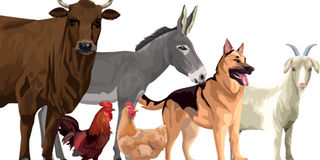How domestic animals transmit diseases to humans

What you need to know:
60% of pathogens affecting humans originate from animals, according to the WHO for Animal Health
63% -Percentage increase in diseases jumping from animals to people this decade
6/10- Number of sick people in Africa today likely to have a disease that jumped from an animal
There are many theories regarding the cause of the Covid-19 pandemic. Some have been proven, while others remain hypothetical. One thing that scientists agree on is that Covid-19 is a zoonotic disease.
This means that its virus likely came from an animal and jumped to a human being before it started ravaging the world’s population. This, however, is not the first, neither will it be the last, zoonotic disease.
As long as we continue to live with animals, existing and new diseases will always come up. But do we really know the pathogens in some of those animals can be prevented from infecting us?
We often share our lives with some of those animals as a sign of love. However, many harbour unseen “partners” that are not ideal companions for us.
Man’s best friend, the dog, may lick you and you may feel loved, only to fall sick days later. It won't be an accident, especially if your dog has not been taken care of.
Due to animal-to-human diseases, experts are calling on animal and pet lovers to re-evaluate how close they get to the animals.
Prof John Bradshaw, a biologist and an honorary research fellow at the University of Bristol, in his new book The Animals Among Us: How Pets Make Us Human, says that our fascination with pets is not because they are useful, nor even because they are cute, and certainly not because they will make us live longer.
Instead, animal keeping remains an intrinsic part of human nature, rooted deeply in our own species’ evolution.
Prof Bradshaw says there is evidence that interacting with pets reduces stress in people as long as the pet is well-trained.
Do people, especially those in developing countries, have the luxury of training pets?
According to the World Organisation for Animal Health, 60 percent of pathogens that cause human disease originate from domestic and wild animals, with 75 percent of emerging human pathogens emanating from animals.
Two weeks ago, the World Health Organisation (WHO) warned that diseases transmitted from animals to people in Africa have increased to 63 per cent in the last decade, compared with the previous 10-year period.
This means that in Africa today, six out of 10 people that are unwell are likely to be infected by diseases that jumped from an animal.

The analysis by WHO finds that since 2001, of the 1,843 substantiated public health events that were recorded in the African region, 30 percent were zoonotic outbreaks.
“While the numbers have increased over the past two decades, 2019 and 2020 saw a particular spike, with zoonotic pathogens accounting for half of all public health events. The diseases account for a substantial burden of disease, resulting in about a billion sick people, and millions of deaths globally every year,” said Matshidiso Moeti, the WHO regional director for Africa.
Dr Moeti indicated that Africa is a hotbed for zoonotic diseases including brucellosis and leptospirosis, rabies, trypanosomiasis, Rift Valley fever, onchocerciasis anthrax, yellow fever, Ebola, Lassa fever and Covid-19.
Due to the lack of robust bio-surveillance and reporting infrastructure in Kenya, the disease occurrences have been considerably underreported or unreported over the years by both human and animal health agencies.
Not reported
Prof Thumbi Mwangi, a researcher at the Kenya Medical Research Institute, conducted a study on the extent of zoonotic diseases reported in Kenya. It was published in the scientific journal Nature and it reveals that not all zoonotic cases are reported.
From the findings, Rift Valley fever (RVF) accounted for 47 percent, anthrax (45 percent), and rabies (nine per cent) of the events.
“No brucellosis or trypanosomiasis-related disease events were identified in Kenya during the study period of 2016 to 2020,” says the study.
The data was harvested by Biofeeds from 1,874 news records. A total of 424 distinct disease reports regarding disease occurrences in Kenya were identified.
The other 1,450 records were either informative articles, disease warning news, scientific literature, or miscellaneous articles that included homonyms of key search terms.
Healthy Nation looked at some of the animals that stay closer to humans that potentially have pathogens that cause diseases.
Mostly, the diseases are transmitted through soil, water, air, mechanical vector, and biological vector when humans ingest and inhale the disease-causing pathogens.
Cattle, goats and sheep
There are a number of pathogens that these animals carry, which end up being detrimental to people’s health when they find a way to their bodies. Some of the diseases they cause include anthrax, brucellosis, Query fever (Q fever), Rift Valley fever, scabies, among others.
People are either infected when they come in direct contact with the animals, eat them, inhale spores from the animals or get bites through insects that have been in contact with infected animals.
Query fever, for instance, is contracted when someone breathes dust from an infected animal.
“The bacteria may be stirred up in dust and carried for long distances by wind, which can lead to infections miles from affected animals. People can also get Query fever through direct contact with placental material or other birthing products, urine, faeces, or unpasteurised dairy products from infected animals, or by handling other contaminated materials, such as wool, straw, fertiliser, and laundry,” explain scientists from the Washington State Department of Health.
Chicks and ducklings
The seemingly harmless cute little offsprings of your favourite birds can be conduits for diseases.
At face value, they appear clean and healthy. However, scientists say that chicks and ducklings have a bacteria called salmonella which can lead to serious illnesses. When people come in contact with them, they are advised to wash their hands to avoid passing the bacteria to other people.
Researchers from the Washington State Department of Health say that children are more likely to get the bacteria because they are least likely to wash their hands after touching chicks and ducklings.
“Symptoms of salmonella infection begin about one to three days after exposure and include diarrhoea, fever, and stomach pain. Illness usually lasts four to seven days and most people will recover without medical treatment,” says a publication from the Washington State University.
Scientists advise that people should keep their poultry away from areas that they live. They add that if people must interact with chicks and ducklings, they have to wash their hands with soap and water to keep the bacteria at bay.
Pigs
More than half the genes in the H1N1 virus behind some flu outbreaks were traced to pigs. The first person known to fall sick with swine flu in Mexico, the outbreak’s epicentre, lived near an industrial farm that produces almost a million pigs a year.
According to the Centres for Disease Control, the virus dubbed “swine flu” from swine influenza is a respiratory disease of pigs caused by type A influenza viruses that cause animal outbreaks.
The spread between pigs and people is thought to happen mainly when an infected pig (or human) coughs or sneezes and droplets with influenza virus in them spread through the air.
If these droplets land in the nose or mouth or are inhaled, that person (or pig) could be infected. There also is some evidence that the virus might spread by touching something that has a virus on it and then touching the mouth or nose.
Inhaling particles containing the influenza virus is another possible way of getting infected.
Most illnesses have been mild, but as with seasonal flu, hospitalisation and death can occur.
Signs of the disease are similar in humans and pigs. They include fever, coughing , sneezing, breathing difficulties, eye redness or inflammation, and lack of appetite.
To take care of the pigs and to avoid the spread of the virus, the CDC recommends vaccination of herds and caretakers with seasonal influenza vaccine. It also calls for maintaining cleanliness at swine barns and cleaning the feeding and drinking equipment. Using proper ventilation systems in pigsties is also recommended.
Dogs
Humans are fond of dogs. They are mostly used as security while some people keep them as pets. Studies have found that apart from rabies which is mostly caused by dog bites, the animal's mouth carries a bacterium, Capnocytophaga canimorsus, which is responsible for hospitalisation.
It is said that even healthy dogs harbour the bacteria in their mouths and humans coming into contact with these bacteria rarely suffer any medical consequences — except those with reduced immune function including the elderly and even pregnant women.
Mostly, the bacteria is spread by being licked by a dog. The consequences can be extreme when not treated. They include amputation. Also, dog bites can lead to infection and illness.
Rabies remains responsible for about 60,000 human deaths annually, mostly in developing countries. In Kenya, an estimated 2, 000 people die annually of rabies due to bites from rabid dogs.
Africa accounts for 36 percent of the 59,000 rabies deaths in humans annually.
Rabies, a viral disease spread through an animal bite, has had an effective vaccine for more than a century. Yet people continue to die from the disease.
Apart from rabies, dogs can spread a range of other disease-causing organisms, including salmonella. There is also Toxocara canis, a parasite that can cause blindness in humans.
To protect dogs from diseases, dog owners should keep up with vaccination routines. With vaccination, one can prevent diseases like rabies, worms, bordetella, Lyme disease, parvovirus, leptospirosis and distemper.
Feed the dogs on well-cooked food and wash your hands after handling the animals.
Cats
Most families in the country have a cat as a pet, not knowing that they harbour pathogens that cause diseases including toxoplasmosis, cat roundworm and cat scratch disease that can be passed to humans, sometimes with severe health consequences.
A study published in the journal Wildlife Research last year, and which was done in Australia, estimates that more than 8,500 Australians are hospitalised and about 550 die annually as a result of the cat-related diseases.
The data obtained from the Australian Bureau of Statistics looked at the rate of transmission of the diseases and their health effects on humans.
Toxoplasmosis is an illness caused by the parasite Toxoplasma gondii. It is the most serious cat-dependent disease. The cats shed their eggs in their droppings, which survive for months. Humans become infected when they ingest these oocysts that are in the soil and the dust in places where cats have defecated, especially in sandpits, vegetable gardens or kitty litter.
When infected, one exhibits flu-like symptoms that resolve within a couple of weeks.
For people with compromised immune systems, including those with cancer or HIV and pregnant women, the risk may be slightly higher.
Another risk is the cat scratch disease is a bacterial infection (Bartonella henselae) that people can contract if bitten or scratched by an infected cat.
Typical symptoms include sores, fevers, aches, and swollen glands. But more serious symptoms, such as inflammation of heart tissue, cysts in the organs and loss of vision can also occur.
There are no human vaccines for this disease.
Cat owners are advised to keep pet cats indoors or in a securely contained outdoor area to reduce the chance of contracting or passing on disease-causing pathogens.
Cats should be kept out of veggie gardens and children’s sandpits.
Washing hands after handling kitty litter, gardening, and washing vegetables thoroughly can also reduce the risk of transmission.
People are advised to also cook meat, poultry, or eggs well before feeding their cats. Also, keep your cat away from other cats.
Bats
Bats, the tiny mammals hovering over your home, are majorly the origin of deadly viruses including Marburg, Ebola, and severe acute respiratory syndrome.
Scientists say bats are more likely to carry unknown pathogens that can wreak havoc on humans.
Most emerging infectious diseases are zoonoses –diseases that originate in animals – and some may have the potential to trigger massive epidemics.
A study by disease ecologist Peter Daszak of the EcoHealth Alliance in New York City and his colleague, ecologist Kevin Olival, collected information on all viruses known to infect mammals, 586 in total and found in 754 species.
The researchers counted the number of disease-related publications on each species. The researchers then calculated how many viruses they would expect to find in each species, the results gave them an estimation of viruses in each mammal species.
In the study published in the scientific journal Nature, bats were found to host a significantly higher proportion of zoonoses than other mammals including Nipah virus (NiV), with a warning that there is no reason to fear or fight them.
“Bats have many useful roles, from pollinating flowers to controlling insects. And virus outbreaks are not inevitable as long as humans keep their distance," Dr Daszak says.
"These viruses will only emerge in people if we continue encroaching into bat habitat, hunting and eating them, and otherwise making contact with them." He advises that people should avoid areas where bats are known to roost.
Do not eat or drink items that bats touch.




